Lots of Ford Escape owners have said they’re having trouble with their cars, especially at night. This can make driving unsafe because it’s hard to see. If you’re dealing with these problems or thinking about getting new headlights, it’s important to know what’s causing them and how to fix them.
This article looks at what Ford Escape owners have experienced, using their stories, advice from experts, and simple solutions to help you figure out your Ford Escape headlight problems and make your drives safer and brighter.
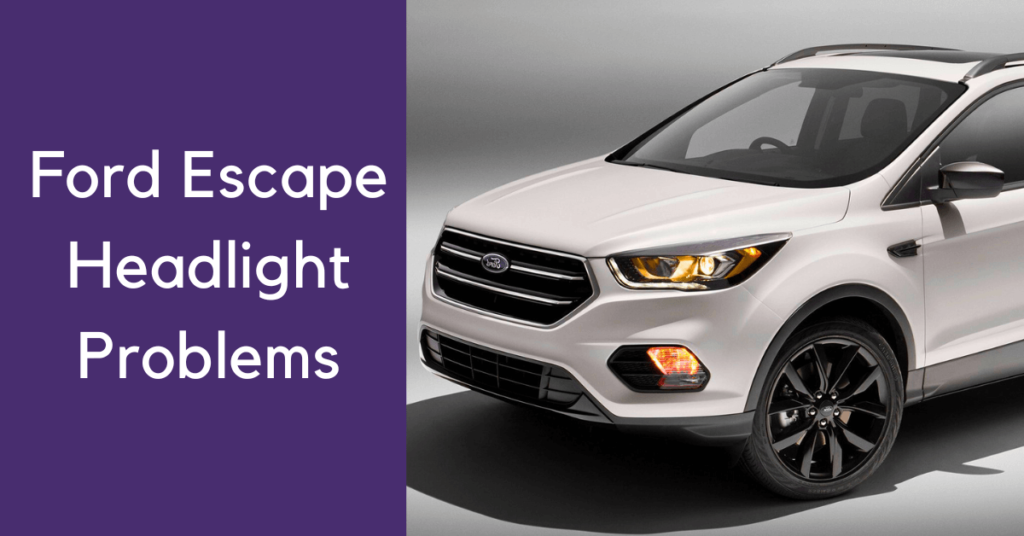
Following Are The Ford Escape Headlight Problems:
1. Passenger’s Side Headlight Not Working
If your Ford Escape’s passenger-side headlight isn’t working, it means that the light on the right side of your car, near where the passenger sits, is not turning on when you switch on your headlights.
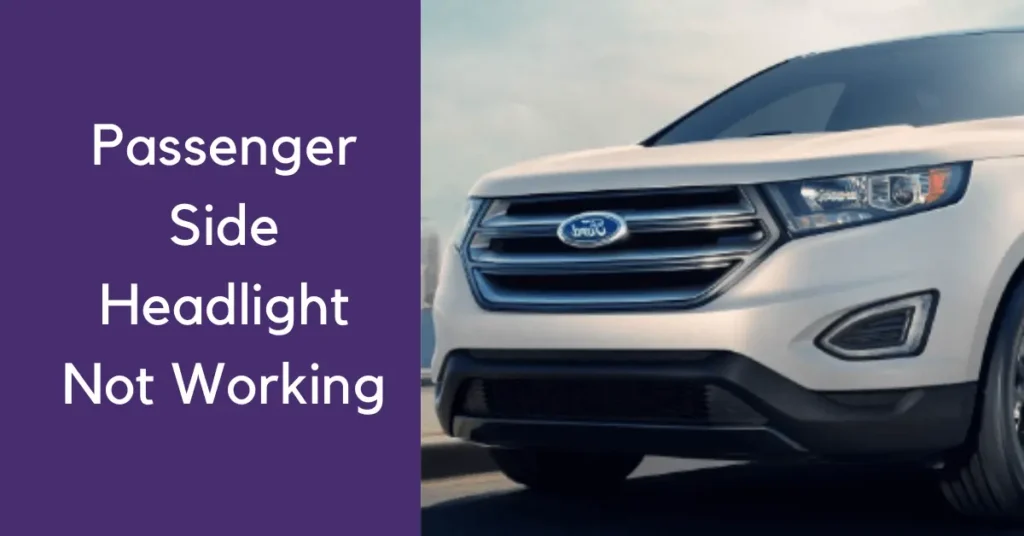
If your Ford Escape’s passenger-side headlight isn’t working, there could be a few reasons why. One possibility is that the light bulb itself has burned out, just like a regular light bulb in your home can stop working over time.
Another reason could be a problem with the fuse, which is like a tiny switch that controls the flow of electricity to the headlight. If the fuse is blown, it needs to be replaced so that electricity can reach the headlight again.
Sometimes, there might be a problem with the wiring, which is like the electrical pathways in your car. If the wiring is damaged or disconnected, electricity can’t travel to the headlight properly, causing it to stay off. You don’t need professional help for this Ford Escape headlight problem because by just following the steps below, you can fix it yourself.
How to Fix it?
Open the hood of your car. Look for the back part of the headlight on the passenger side. If the bulb inside looks dark or broken, that’s likely the problem. You’ll need to get a new bulb from an auto parts store.
To replace the bulb, you usually just twist or pull out the old one and put the new one in its place. Remember not to touch the glass part of the new bulb with your fingers.
If the bulb looks okay but the headlight still doesn’t work, there might be a problem with the fuse. You can find the fuse box inside your car or under the hood. Check if the fuse for the headlight is blown. If it is, you’ll need to replace it with a new one of the same size.
2. Passenger’s Side Taillight Not Working
If your passenger side taillight isn’t working, it means the red light at the back right side of your car, which turns on when you switch on your headlights or brake, isn’t lighting up.
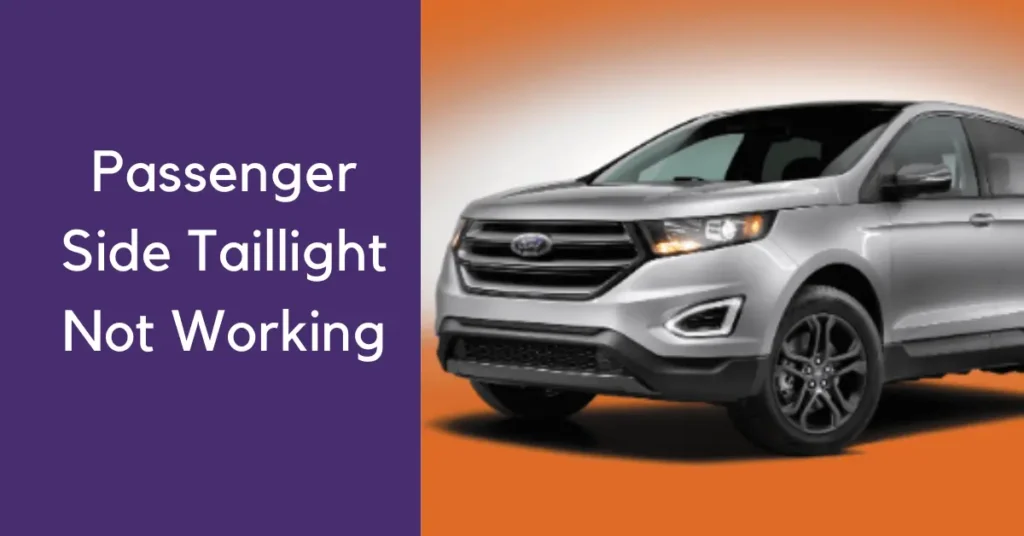
This could happen for a few reasons. The bulb might be burned out, similar to a light bulb in your house that stops working. Another possibility is a problem with the fuse, which is like a small switch controlling electricity flow to the taillight.
If the fuse is blown, it needs to be replaced so electricity can reach the taillight again. Sometimes, it might be an issue with the wiring, which is like the electrical pathways in your car. If the wiring is damaged or disconnected, electricity can’t travel properly, and the taillight stays off.
You don’t need professional help for this Ford Escape headlight issue because by just Checking these parts and fixing the issues you can usually solve the problem and make your car safer for driving.
How to Fix it?
First, you’ll need to check if the light bulb is burnt out. You can do this by opening the trunk and finding the back of the taillight. If the bulb looks dark or broken, you’ll need to replace it with a new one. You can buy a replacement bulb from an auto parts store.
To replace the bulb, you usually just twist or pull out the old one and put the new one in its place. Make sure not to touch the glass part of the new bulb with your fingers.
If the bulb looks okay but the taillight still doesn’t work, there might be a problem with the fuse or the wiring. Checking the fuse box inside your car or under the hood can help you determine if the fuse needs to be replaced. If it does, you’ll need to replace it with a new one of the same size.
3. Insufficient Illumination at an Undisclosed Speed
If your Ford Escape is showing a message like “Insufficient Illumination at an Undisclosed Speed,” it likely means that there’s a problem with the lights on your car. This could be with the headlights, taillights, or interior lights. The message is saying that the lights aren’t working well enough when you’re driving, but it doesn’t say how fast you’re going.

This can happen if the headlights, taillights, or inside lights aren’t working properly. Maybe the bulbs are burned out, the wires connecting them are damaged, or a fuse related to the lights has blown out. Sometimes, as cars get older, their lights become dimmer, making it harder to see at night. You don’t need professional help for this Ford Escape headlight issue because by just following the steps below you can usually solve the problem and make your car safer for driving.
How to fix It?
To fix this problem in the Ford Escape headlight problems, start by checking the lights. Look at the headlights, taillights, and interior lights to see if any bulbs are burned out. If you find any, replace them with new ones. Then, inspect the wiring that connects the lights to the car’s electrical system. Make sure the wires are not damaged or disconnected. If you see any issues, you might need to repair or replace the wiring. Additionally, check the fuses related to the lights. If any are blown, replace them with new fuses of the same rating. If your car’s lights are gradually becoming dimmer over time, consider replacing them with brighter bulbs.
Headlight Problems in Other Ford Models:
- Ford Kuga headlight Problems
- Ford ranger headlight problems
- Ford figo headlight problems
- Ford focus headlight problems
- Ford B Max headlight problems
- Ford escape headlight problems
- Ford Flex Headlight Problems
4. Low Beam Ford Escape Headlight Not Working
If the low beam headlight on your Ford Escape is not working, it means that the specific light designed to illuminate the road directly in front of your vehicle is not functioning as intended. This could result in reduced visibility while driving at night or in low-light conditions, potentially compromising your safety and the safety of others on the road.

The low beam headlight in a Ford Escape might not work due to a few simple reasons. First, the bulb could be burned out, meaning it needs to be replaced. Second, there might be a problem with the wiring that connects the headlight to the car’s electrical system, which could be damaged or disconnected. Third, a fuse related to the headlights might have blown out, cutting off power to the low beam. Lastly, if the vehicle has HID headlights, a defective ballast could be the issue.
You don’t need professional help for this Ford Escape headlight issue because by just following the steps below you can fix this problem.
How to fix it?
Sometimes, the switch itself can become faulty, preventing the low beams from turning on. Try toggling the headlight switch on and off a few times to see if that resolves the problem. If the low beams still don’t work, consider replacing the headlight switch with a new one. This fix is relatively simple and can be done without much technical expertise.
5. Condensation in Ford Escape Headlights
If you notice condensation inside the headlights of your Ford Escape, it typically indicates a problem with the seal of the headlight assembly. Condensation occurs when moisture from the air gets trapped inside the headlight housing.
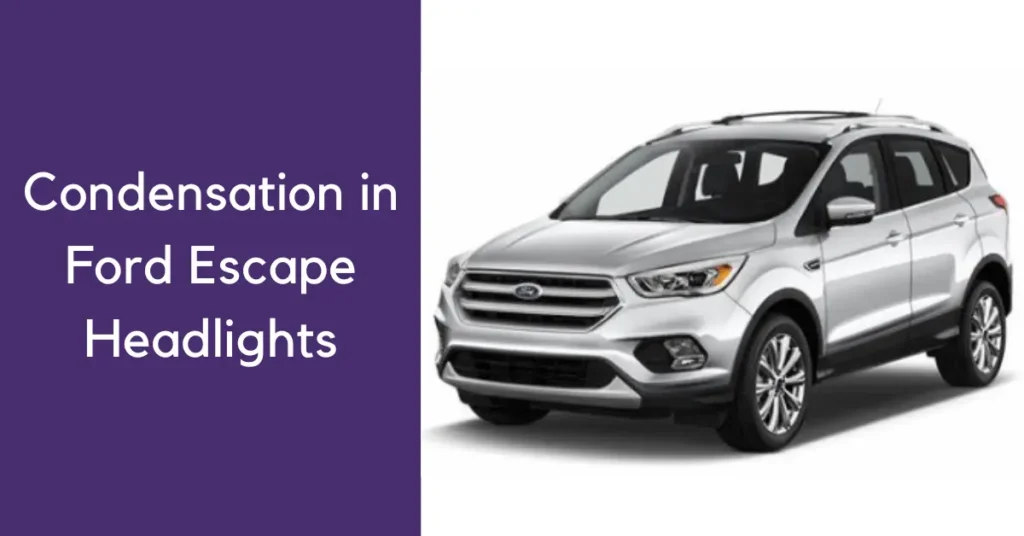
This can happen due to a variety of reasons, such as damaged or improperly sealed headlight covers, cracks or holes in the headlight housing, or changes in temperature and humidity. Condensation inside the headlights can affect visibility and may lead to premature wear or damage to the internal components of the headlight assembly.
You don’t need professional help for this Ford Escape headlight issue because by just following the steps below you can fix it yourself.
How to Fix it?
First, start by removing the headlight assembly from the vehicle. Next, carefully inspect the seals around the headlight cover for any damage or wear. If you notice any cracks or gaps, you may need to replace the seals to create a tight seal. Additionally, check the headlight housing for any cracks or holes that could be allowing moisture to enter. If you find any, you can use silicone sealant or epoxy to seal them. Once the seals and housing are properly sealed, allow the headlights to dry completely before reinstalling them onto the vehicle. This should prevent further condensation from forming inside the headlights. If condensation persists despite these efforts, it may be necessary to replace the entire headlight assembly.
6. Headlights Cutting On and Off Over Bumps
If your Ford Escape’s headlights are cutting on and off intermittently when driving over bumps, it suggests a potential issue with the electrical connections or components related to the headlights.
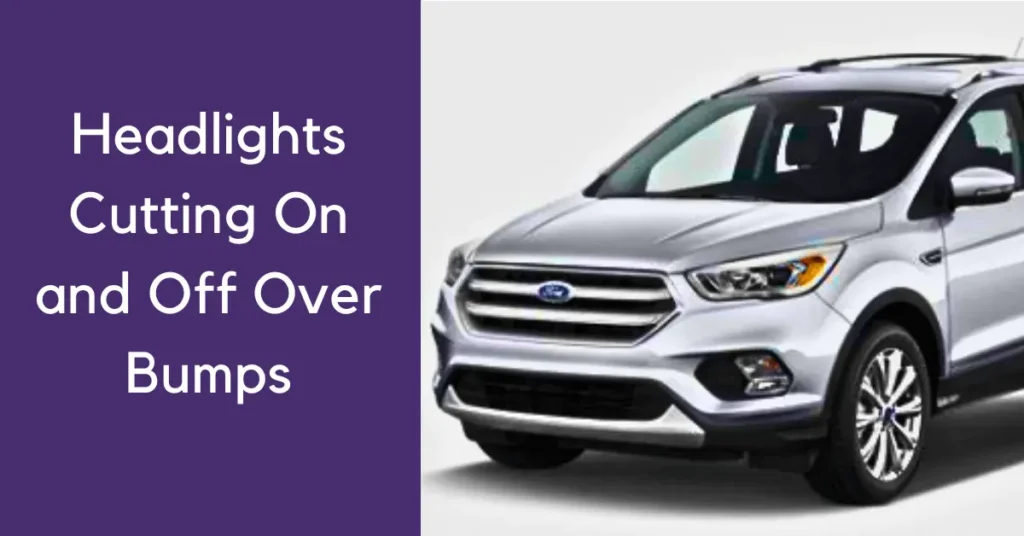
This problem could be caused by several factors, including loose wiring connections, a faulty headlight switch, a defective relay, or a damaged component in the headlight circuitry. When driving over bumps, the movement and vibration can disrupt the electrical connection, causing the headlights to flicker or turn off momentarily.
How to Fix it?
Start by checking the wiring connections related to the headlights. Ensure that all connections are secure and free from corrosion or damage. If you find any loose connections, tighten them securely. Next, inspect the headlight switch and the relay associated with the headlights for any signs of wear or malfunction. If necessary, replace these components with new ones. Additionally, examine the headlight bulbs and sockets for any damage or signs of overheating. If any issues are found, replace the bulbs or sockets as needed. Lastly, consider installing a stabilizer or additional support for the headlight assembly to reduce the impact of bumps on the electrical connections.
7. Dash Lights Not Dimming Automatically
If the dash lights in your Ford Escape aren’t dimming automatically, it means that the feature designed to adjust the brightness of the dashboard lights based on the ambient light conditions isn’t working properly. Normally, this feature dims the dashboard lights when it’s dark outside and brightens them when it’s lighter.
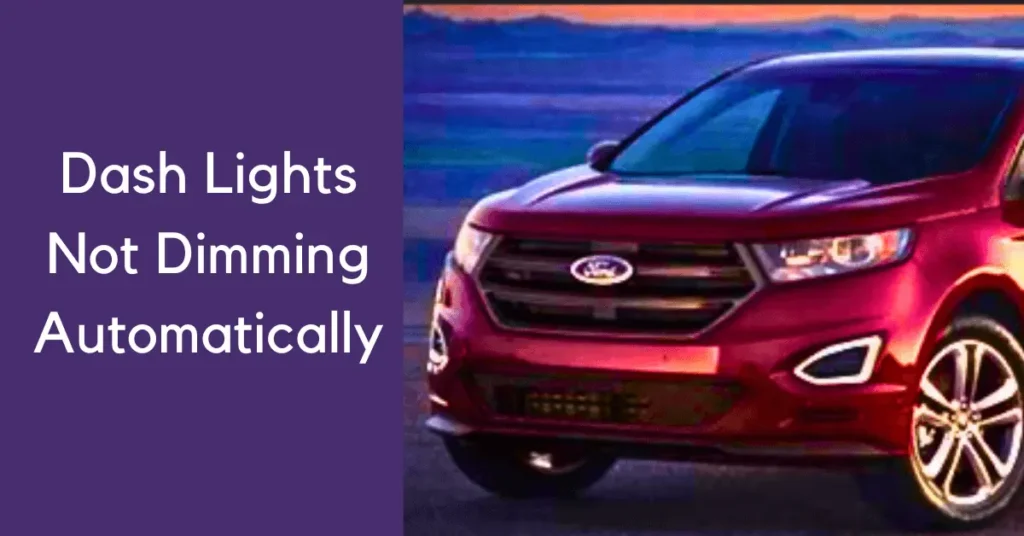
The dash lights not dimming automatically in your Ford Escape could be caused by a few things. One possibility is that the ambient light sensor, which detects the level of light outside the vehicle, may be malfunctioning, leading to incorrect readings. Another potential cause could be a problem with the dimmer switch itself, preventing it from adjusting the brightness of the dash lights as needed.
How to Fix it?
One of the simplest fixes for dash lights not dimming automatically in your Ford Escape is to check the dimmer switch located on the dashboard. Sometimes, the switch might accidentally be set to the maximum brightness, preventing the automatic dimming feature from working correctly. Try adjusting the dimmer switch to see if it resolves the issue. If the switch appears to be functioning properly but the problem persists, you can also try resetting the vehicle’s electrical system by disconnecting the battery for a few minutes and then reconnecting it. This can sometimes reset any electronic glitches causing the automatic dimming feature to malfunction.
8. Headlights Fogging While Driving at Night
If your headlights are fogging up while driving at night, it means that moisture is getting inside the headlight housing and causing condensation.

This can happen due to temperature differences between the inside and outside of the headlight, as well as changes in humidity. Fogged headlights can reduce visibility and make it harder to see while driving in the dark, which can be dangerous.
You don’t need professional help for this Ford Escape headlight issue because by just following the steps below you can reverse your problem.
How to Fix it?
To fix this issue, you can try removing the moisture by opening the hood and letting the headlights dry out, or using a hairdryer on a low setting to blow warm air into the headlights. Additionally, sealing any cracks or gaps in the headlight housing can help prevent moisture from getting inside in the future.
9. Corroded Ford Escape Headlight Lens
If the headlight lens of your Ford Escape is corroded, it means that the protective coating on the lens has deteriorated, often due to exposure to environmental factors like sunlight, moisture, and road debris. Corrosion can cause the lens to become cloudy, hazy, or discolored, which can reduce the effectiveness of the headlights
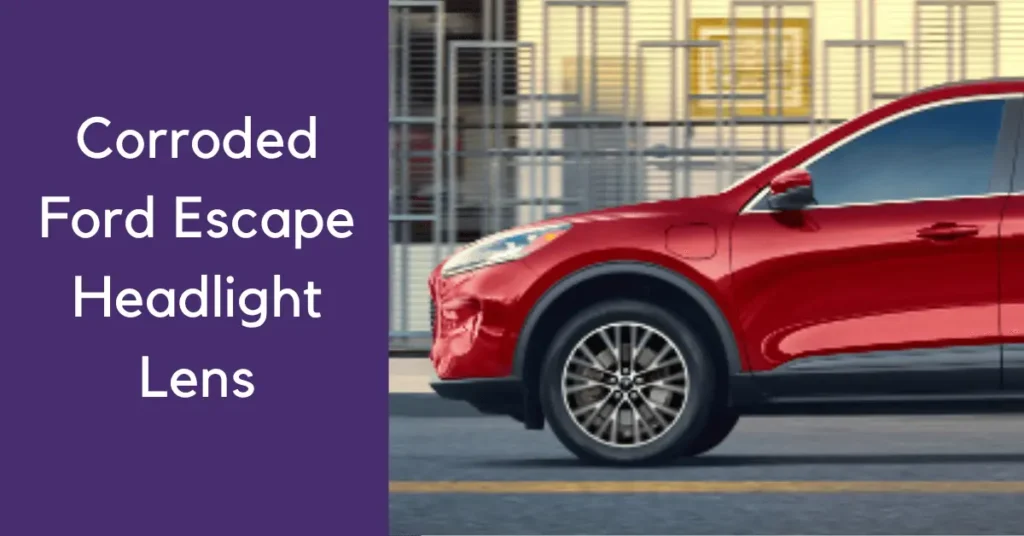
The main causes of a corroded headlight lens in a Ford Escape typically stem from exposure to environmental factors over time. These include sunlight exposure, moisture from rain or car washes, road debris, and chemical exposure from substances like road salts or cleaning agents. These elements can degrade the protective coating on the headlight lens, leading to corrosion and discoloration.
How to fix it?
One easy way to address a corroded headlight lens in your Ford Escape is by using a headlight restoration kit, which you can purchase from an automotive store. These kits typically include everything you need to clean, polish, and restore the clarity of the headlight lens, such as sandpaper, a polishing compound, and a protective sealant.
Follow the instructions provided in the kit carefully, which usually involve sanding the lens to remove the corrosion, polishing it to restore clarity, and applying a protective sealant to prevent future corrosion. Alternatively, you can try household remedies like toothpaste or baking soda mixed with water to clean and polish the lens. If the corrosion is severe or the lens is damaged, replacing it with a new one may be necessary.
5 Prevention Tips For Ford Escape Headlight Problems

1) Check Headlight Functionality Regularly:
Checking headlight functionality refers to checking the functionality of high beams, low beams, turn signals, light intensity, color consistency, automatic activation, and fog lights.
What To Check:
- High and low beams: Turn them on and check for brightness and proper focus. Are they strong enough to light the road?
- Turn signals and fog lights: Ensure they activate correctly and display the appropriate colors. Imagine other drivers needing to see your signals.
- Color consistency: While headlights typically have a white or slightly blueish hue, mismatched or uneven colors might indicate an issue.
How To Check:
- Park your car in a dark area with a flat surface ahead.
- Turn on your headlights and walk around the vehicle, observing their functionality and beam pattern.
- Ask a friend to sit inside and activate turn signals/fog lights while you observe them from outside.
Always, keep in mind that well-functioning headlights improve visibility at night and in low-light conditions, helping you spot hazards and avoid accidents.
2) Replace Bulbs Proactively:
Replacing bulbs proactively even before they completely fail is a good way to maintain optimal visibility.
Consult your owner’s manual or manufacturer information to understand the average lifespan of your Ford Escape’s headlight bulbs. Additionally, when replacing one bulb, consider replacing the other even if it still works. This ensures consistent brightness and avoids replacing the remaining bulb soon after. While choosing the bulb, make sure the replacement bulb is high quality (LED bulbs) and compatible with your specific Ford Escape model and headlight configuration.
3) Align Headlights Properly:
Misaligned headlights pose serious safety risks by reducing visibility and distracting other drivers. They can be misaligned due to:
- Normal wear and tear: Over time, components can shift, affecting alignment.
- Hitting bumps or potholes: Impacts can jolt headlights out of alignment.
- Modifications or repairs: Certain repairs or modifications may affect alignment.
Signs of misalignment:
- Uneven light pattern: One headlight aiming higher or lower than the other.
- Complaints from other drivers: If they find your headlights too bright or misdirected.
- Reduced visibility: You don’t see the road ahead clearly at night.
Alignment recommendations:
- Seek professional alignment at least once a year: This ensures accurate and safe adjustments by qualified technicians.
- Check for signs of misalignment more frequently: Especially after hitting bumps or experiencing potential impacts.
- Consult your owner’s manual: Only attempt DIY adjustments if your model offers them and you’re confident and equipped for safe adjustments. Remember, prioritizing professional service is crucial for optimal safety and performance.
4) Regular Professional Servicing:
Regular professional servicing for your Ford Escape headlights goes beyond basic cleaning. It ensures optimal performance and prevents potential issues by:
- Performing comprehensive checks: This includes headlight alignment, bulb condition, aiming verification, reflector cleaning, and other crucial aspects.
- Catching problems early: Professionals have the expertise and equipment to identify minor issues like wear, moisture buildup, or wiring concerns before they become major problems.
- Maximizing efficiency and lifespan: Regular servicing helps ensure your headlights function optimally, potentially extending their lifespan.
5) Warranty Awareness:
Understanding your Ford Escape warranty coverage can be beneficial when facing headlight issues. Remember:
- Coverage varies: Headlight components may or may not be covered under your warranty depending on its terms and the specific issue. Consult your owner’s manual, dealership, or manufacturer’s website to understand your specific coverage details.
- Benefits beyond cost savings: Warranties provide peace of mind knowing certain repairs are covered, potentially saving you from unexpected expenses.
- Review exclusions: Warranties often have limitations and exclusions. Carefully review your warranty terms and conditions to understand what’s covered and what’s not.
Headlight Problems in Lexus Models:
fAQS
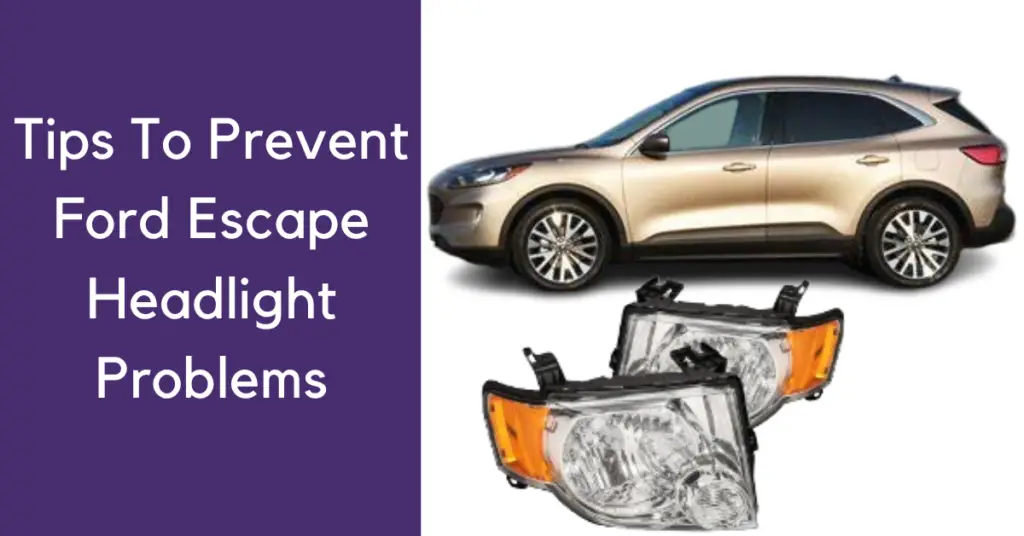
q1: what is the cost of repairing ford escape headlights?
The cost of repairing Ford Escape headlights varies depending on the issue and model year. Simple fixes like bulb replacement range from $20 to $100, while more complex repairs such as assembly replacement can cost $100 to $500+. Costs may vary based on parts and labor, so getting quotes from mechanics is recommended.
q2: What tools are required to fix Ford Escape Headlight problems?
To fix Ford Escape headlight problems, you may need a screwdriver set, pliers, socket wrench set, electrical tester, headlight restoration kit, replacement bulbs, and safety equipment like gloves and safety glasses.
Q3: Why do my Ford Escape headlights keep burning out frequently?
If your Ford Escape headlights are burning out frequently, it may be due to excessive voltage. Check the vehicle’s electrical system and ensure it is within the specified voltage range. Additionally, inspect the headlight wiring for any issues and replace any damaged components.
Q4: What should I do if my Ford Escape headlights are dim or uneven?
Dim or uneven headlights can be caused by oxidized or dirty lenses. Clean the headlight lenses thoroughly to improve brightness. If the issue persists, consider replacing the headlight bulbs or consulting a professional for further diagnosis.
Q5: How can I fix condensation inside my Ford Escape headlights?
Addressing condensation inside Ford Escape headlights involves checking the seals for damage and ensuring they are properly sealed. Replace damaged seals and consider using a moisture-absorbing product inside the headlight assembly. If the problem persists, seek professional assistance.
q6: Are the headlight problems and solutions mentioned above also suitable for other models of ford escape?
Yes, the headlight problems and solutions mentioned above are generally applicable to other models of the Ford Escape as well. While there may be slight variations in the design or components among different model years of the Ford Escape, the basic principles of diagnosing and fixing headlight issues remain similar across the board.
Q7: Why do my Ford Escape headlights flicker intermittently?
Flickering headlights may be a result of a faulty headlight switch or a loose wiring connection. Inspect the headlight switch and wiring for any issues, and replace or tighten components as needed. If the problem persists, consult a professional for a thorough electrical system inspection.
Q8: How do I replace a burnt-out headlight bulb on my Ford Escape?
To replace a burnt-out headlight bulb on your Ford Escape, locate the headlight assembly, usually accessible from under the hood. Twist the bulb socket counterclockwise to remove it, then replace the old bulb with a new one. Ensure proper alignment and secure the bulb socket by twisting it clockwise.
Q9: What should I do if both of my Ford Escape headlights are not working?
If both headlights on your Ford Escape are not working, first, check the headlight switch to ensure it is in the “on” position. Inspect the fuses related to the headlights and replace any blown fuses. If the issue persists, consult a professional to diagnose potential electrical problems in the vehicle.
Remember, for specific issues, it’s recommended to consult with a qualified mechanic or the Ford dealership.
Headlight Problems in Other Car Models:
Conclusion
In conclusion, navigating Ford Escape headlight problems can be daunting, but with these nine practical solutions, you can shine a light on any issue. We encourage you to share your experiences, comment on what worked for you, and learn from others facing similar challenges.
